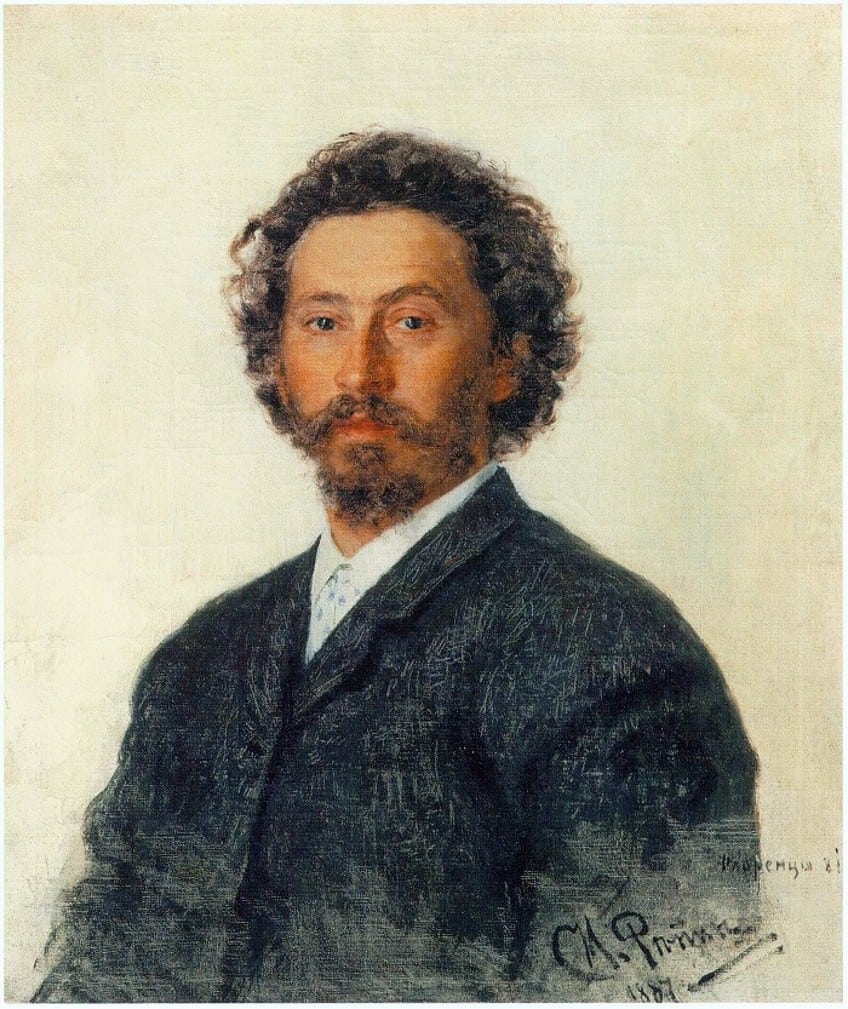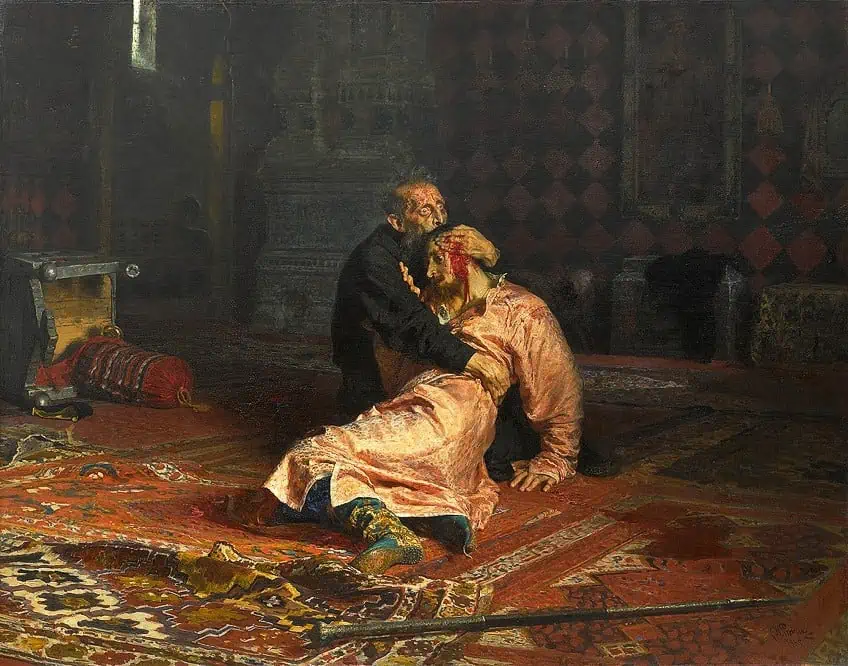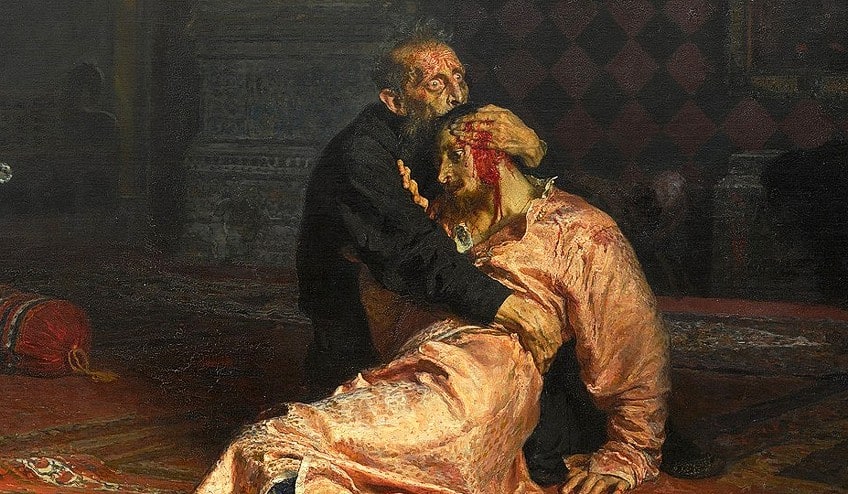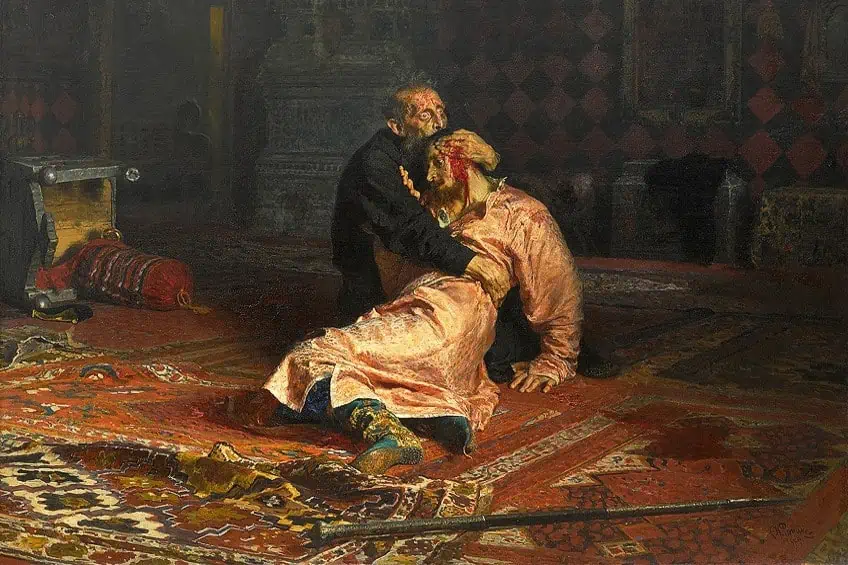“Ivan the Terrible and His Son” by Ilya Repin – A Quick Study
Who is Ivan the Terrible, and what is the Ivan the Terrible painting about? Ivan the Terrible was Russia’s first crowned tsar, and the painting depicts the moment after he had fatally struck his son in the head during an argument. The painting, Ivan the Terrible and His Son by Ilya Repin, was regarded as very controversial when it was produced and has even been vandalized multiple times. To find out more about Ivan the Terrible and his son Ivan’s story, carry on reading below!
Contents
Exploring the Ivan the Terrible Painting
Ivan the Terrible had a notoriously bad temper, especially as he grew older. Many believe that this was because he suffered from mental instability in his old age. During a rather heated argument, the topic of which is still of much debate, Ivan the Terrible grew enraged and struck his son on the head with his staff. This painting represents the moment after the father has realized what he has done, sitting on the floor, cradling his dying son in his arms. Before learning more about Ivan the Terrible and his son Ivan’s story, let’s introduce the artist of the Ivan the Terrible painting, Ilya Repin.
Introducing Ilya Repin (1844 – 1930)
| Artist Full Name | Ilya Yefimovich Repin |
| Nationality | Ukrainian-Russian |
| Date of Birth | 5 August 1844 |
| Date of Death | 29 September 1930 |
| Place of Birth | Chuhuiv, Ukraine |
Repin grew up in a poor household and witnessed the oppression of lower-class citizens firsthand as a child. He was brought up in a regional town far from the Empire’s cultural centers, with little hope for any formal kind of education or training. His humble upbringing, however, did not inhibit his potential. He became an apprentice for a painter, gaining the skills necessary to produce the masterful works he would subsequently be known for. With his immense technical skills, combined with his experiences of growing up in poverty, he was able to produce works that served as social commentaries of the historical and political events of his time, such as the Ivan the Terrible painting.
Repin’s style had a significant impact on the subsequent development of Russian art, and his devotion to Realism, as well as his ability to transmit emotion, influenced many other Russian painters who came after him.
While never a central figure in the Peredvizhniki group, Ilya Repin was nevertheless regarded as one of its most talented artists. This group’s art was known for its realistic portrayal of the lives of Russian citizens. They did not produce artworks with traditional neoclassical themes and rejected the standards of academic art institutions in Russia.

His dedication to depicting Russian life and culture contributed to the preservation of aspects of the country’s past amid a period of immense turmoil in politics and society. However, the artist was an individual of political ambiguity at times and continued to produce artworks of scathing social critique while also producing portraits of Russian intelligentsia and historical works that implied a more favorable perspective of Russian national history and the state.
The French government awarded Repin the Legion of Honour in 1901, yet, his political allegiances remained complex, and he went to several protests against Tsarist repression in 1905.
Ivan the Terrible and His Son by Ilya Repin
| Date Completed | 1885 |
| Medium | Oil on canvas |
| Dimensions | 199 x 254 |
| Current Location | Tretyakov Gallery, Moscow, Russia |
This Ivan the Terrible painting depicts the despair and guilt experienced by the father after striking his son, as well as the son’s compassion, his tears signifying that he had forgiven his father for doing so. Much of the painting is cast in a dark shadow and the rest is occupied by a dark red carpet which matches the red blood streaming from the son’s forehead, amplifying the horrific reality of the situation. The portrayal of the blood was said to be inspired by the blood he had seen at the bullfighting events while exploring Europe in 1883.
In the middle of the painting, we find Ivan the Terrible holding his dying son in his arms, his face contorted by anguish and remorse as the consequences of his rage sink in.
While there is much debate over what made Ivan the Terrible lose his temper on this particular occasion, the moral of Ivan the Terrible and his son Ivan’s story is pretty clear – unchecked fits of rage lead to regretful situations. The death of the son had serious ramifications for the region, as it left no viable heir to the Russian throne. After Ivan the Terrible died in 1584, his unprepared son Feodor I took his place. Following Feodor’s death, Russia experienced a time of political unrest, impoverishment, and war.

So, why did the father and son start arguing in the first place? There are a few theories that have been proposed over the years. One of them states that the son’s pregnant wife had walked past Ivan the Terrible wearing only her undergown, which was regarded as highly offensive. The other theory states that they were arguing over something political. Whatever the reason, the argument escalated to a point where Ivan the Terrible swung his staff in a fit of rage, striking his son on the temple. This was one of many such fits of rage that the father often inflicted on those around him.
While the people of the 16th century did not know anything about mental issues, today it is thought that Ivan the Terrible suffered from temporal lobe syndrome, which could have been the cause of his intense mood swings and fits.
Repin produced a second version, Filicide, in 1909, on a commission from Stepan Ryabushinsky, an art collector, which is now on exhibit at Voronezh Museum of Fine Arts. The artist added a woman in the background and displayed a greater variety of colors than in the original work in this version, and Ivan’s face is slumped over in despair. Repin was an iconic figure in the Realist art movement in Russia, and the Ivan the Terrible painting embodies Realism’s ideas in art.
Realist painters sought to reflect the natural world as it really looked. They strove to depict the truth of their subjects in an accurate and lifelike manner, whether they were portraying people or landscapes. Realist painters devoted careful consideration to communicating their themes’ psychological and emotional elements. Repin’s depiction of Ivan the Terrible’s sorrow and anguish exemplifies this emotional depth.
Controversies and Vandalism
The Ivan the Terrible painting was regarded as controversial since the moment it came off the artist’s easel. In fact, it was the first ever Russian painting to be removed from public view after it was banned by Alexander III in 1885. However, the person who had bought the painting from Repin, Pavel Tretyakov, began exhibiting the work shortly after this ban was lifted three months later. The painting has been vandalized twice over the years, the first time in 1913 and then again in 2018. In the first incident, a member of an Eastern Orthodox Christian group known as the Old Believers, Abram Balashov, took a knife and stabbed the artwork three times, leaving long gashes across the faces of Ivan and his son.
Georgy Khruslov, the owner of the gallery in which the painting was exhibited at the time, was so distraught and embarrassed by his inability to prevent the artwork from being destroyed, that he took his own life by throwing himself under a train.
Repin was unsure if he was capable of restoring the work since it had been so badly damaged and he was already 68 years of age. However, he eventually managed to restore it perfectly. The man who had slashed the artwork did not spend any time in prison for the incident as he was subsequently entered into a lunatic asylum after being declared mentally ill. Yet, it was not long before his father, who was an influential figure in the community, was able to get him released. The second incident, which occurred in 2018, involved a man who had struck the painting using one of the poles used to hold the security rope around the painting, resulting in several scrapes on the surface of the canvas.

This time the damage was to the son’s body and luckily, the most significant aspects of the artwork, the faces and the hands, did not incur any damage. In 2019, this individual, named Podporin, was sentenced to two and a half years in prison for damaging the painting.
When the artwork was first shown, it caused controversy, with news sources blaming the artist for too much emphasis on bodily gore.
Yet, the piece drew audiences so large and fervent that police officers on horseback were required to preserve order when it was displayed, and chronicles of the period said that no other painting had ever caused such a disruption. The painting’s accuracy is also highly disputed, given that it was created 200 years after the occurrence, and the act itself is not well recorded. Most agree Ivan murdered his son, though this has never been proven, and others say he actually died of an illness that was prevalent at that time.
Symbolism
The first symbolic role of the painting, according to Repin and his peers at the time, is to show the reality of violence and the rejection of morals. The depiction of Ivan and his son’s altercation serves as a historical event that demonstrates a person’s potential to physically hurt his neighbor or even his own child. It also seems to approach a more profound theological source, demonstrating how Christian forgiveness may repair wrongdoings, even murder. This is demonstrated through the son’s gestures, which reflect that he has already forgiven his father, and holds his father’s arm as if to console him, despite the fact that he was dying from the actions of his father.
The painting did not only contain religious symbolism, though. It was also very politically motivated, as it was inspired by the death of Alexander II. The assassination of Alexander II and the subsequent deaths of his perpetrators, as seen by the artist first-hand, influenced the revolutionary beliefs popular during the period.
This artwork condemns the autocratic aspects of Russian rulers throughout history, implying that unbridled state authority may lead to tragic outcomes, whether in the 16th or late 19th centuries. He thus highlighted the cyclical nature of violent politics in Russia by contrasting these two incidents in Russian history. Both events include the assassination of rulers, emphasizing the country’s history of bloodshed and unrest.
That concludes our look at Ivan the Terrible and His Son by Ilya Repin. While it may have been produced around 200 years after the actual event, for the artist, there were certain political parallels that made the incident a timeless example of moral remorse. While it may be a highly regarded painting today, it was met with considerable contempt when it was first produced, even being banned by Alexander III. The artist himself was often referred to as the people’s painter in the USSR, depicting scenes of everyday people, or scenarios that sometimes served as political propaganda, such as this one.
Frequently Asked Questions
Who Is Ivan the Terrible?
Ivan the Terrible was Russia’s first Tsar, ruling from 1547 until his demise in 1584. Because he strove to establish a single authority and build a unified Russian state, his rule heralded the start of a centralized government in Russia. Personal catastrophes marred Ivan the Terrible’s rule, notably the death of his oldest son and successor in 1581. This event would later be commemorated in the painting Ivan the Terrible and His Son by Ilya Repin. While he may have unified authority and extended the Russian state, his reign was also characterized by brutality and repression. His policies ultimately helped shape Russia’s historical narrative of authoritarian governance.
What Is Ivan the Terrible and His Son Ivan’s Story?
Ivan the Terrible was a Russian Tsar who was renowned for his bad temper. His fits of rage grew even worse in his old age. One day, he got into an argument with his son and heir to the throne, Ivan. Some say that it was over political differences, whereas others claim it was because the son’s wife had dressed inappropriately in front of the father. The argument eventually got so heated that Ivan the Terrible swung his hefty staff towards his sin, striking him against the head. This resulted in a fatal wound and the loss of Russia’s next heir to the throne. Ivan the Terrible’s fits of rage were believed to have resulted from a decline in his mental health.
Who Is Ilya Repin?
Russian artist Ilya Repin was one of the most famous painters of the 19th century, and is primarily recognized for his contributions to the Realism movement and portrayals of Russian life. He had been influenced by the works of Western European Realists such as Edouard Manet and Gustave Courbet, however, he modified the style to reflect the distinctive features of Russian culture. Many of his paintings convey a political or social message, illustrating ordinary people’s problems and criticizing the social and political concerns of the period, such as his Ivan the Terrible painting, Ivan the Terrible and His Son Ivan (1885).
Jordan Anthony is a Cape Town-based film photographer, curator, and arts writer. She holds a Bachelor of Art in Fine Arts from the University of the Witwatersrand, Johannesburg, where she explored themes like healing, identity, dreams, and intuitive creation in her Contemporary art practice. Jordan has collaborated with various local art institutions, including the KZNSA Gallery in Durban, the Turbine Art Fair, and the Wits Art Museum. Her photography focuses on abstract color manipulations, portraiture, candid shots, and urban landscapes. She’s intrigued by philosophy, memory, and esotericism, drawing inspiration from Surrealism, Fluxus, and ancient civilizations, as well as childhood influences and found objects. Jordan is working for artfilemagazine since 2022 and writes blog posts about art history and photography.
Learn more about Jordan Anthony and about us.
Cite this Article
Jordan, Anthony, ““Ivan the Terrible and His Son” by Ilya Repin – A Quick Study.” artfilemagazine – Your Online Art Source. November 1, 2023. URL: https://artfilemagazine.com/ivan-the-terrible-and-his-son-by-ilya-repin/
Anthony, J. (2023, 1 November). “Ivan the Terrible and His Son” by Ilya Repin – A Quick Study. artfilemagazine – Your Online Art Source. https://artfilemagazine.com/ivan-the-terrible-and-his-son-by-ilya-repin/
Anthony, Jordan. ““Ivan the Terrible and His Son” by Ilya Repin – A Quick Study.” artfilemagazine – Your Online Art Source, November 1, 2023. https://artfilemagazine.com/ivan-the-terrible-and-his-son-by-ilya-repin/.



